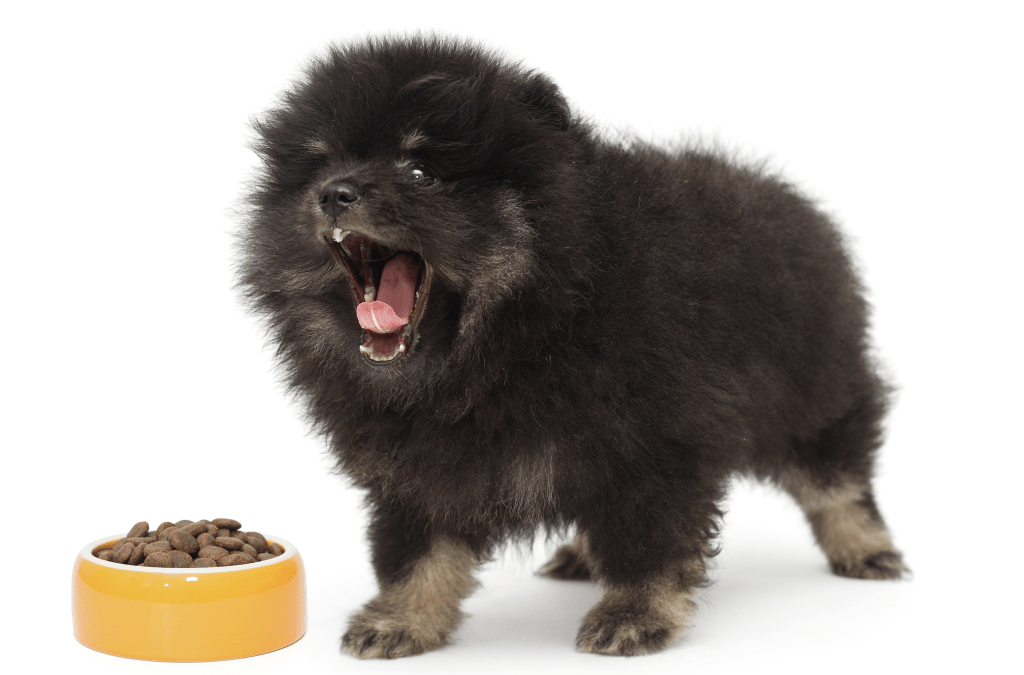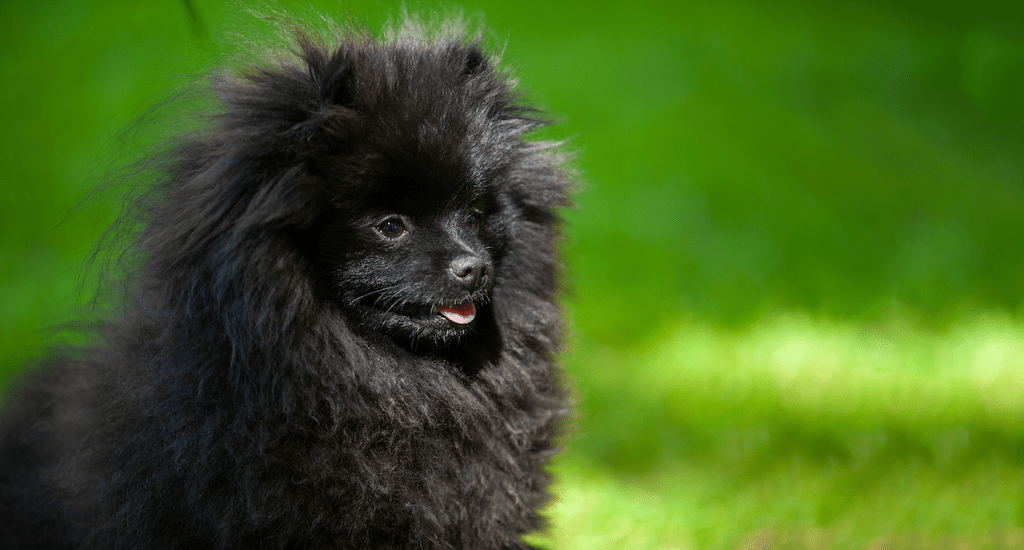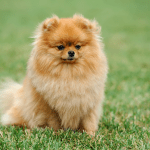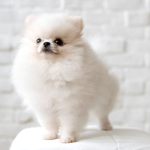Black Pomeranians are a captivating and lovable breed of toy dog, known for their fluffy, teddy bear-like appearance and affectionate personalities. They are characterized by their small size, weighing only 3-7 pounds when fully grown, and their dense, thick coats that come in a striking black color. These furry companions are not only cute and cuddly but also intelligent, adaptable, and fiercely loyal to their owners.
History and origin of black Pomeranians
Pomeranians, including black Pomeranians, are believed to have originated from the region of Pomerania, which was located in present-day Germany and Poland. The breed is a member of the Spitz family of dogs, which includes several other breeds such as the Alaskan Malamute and the Samoyed.
The original Pomeranians were much larger than the modern breed, weighing up to 30 pounds. They were used for herding and as guard dogs. However, over time, smaller Pomeranians became more popular, and the breed was eventually standardized in the late 1800s.
The first black Pomeranians appeared in the breed’s history as a result of selective breeding. Black was not a standard color for Pomeranians, as the breed was predominantly white or cream-colored. However, breeders began to selectively breed for the black color, and today, black Pomeranians are recognized as a distinct variety.
Appearance and personality traits of Black Pomeranians

Black Pomeranians are a small, compact breed that typically weighs between 3 and 7 pounds and stands between 6 and 7 inches tall at the shoulder. They have a distinctive double coat, with a thick, soft undercoat and a longer, coarser outer coat. The black coat of a Pomeranian should be shiny, rich, and vibrant, with no white or gray hairs.
Black Pomeranians are known for their lively and energetic personalities. They are highly intelligent and curious dogs and are often eager to explore their surroundings. They are also affectionate and loving with their owners, and make excellent companion dogs.
Despite their small size, black Pomeranians are often confident and fearless and are not afraid to stand up to larger dogs. However, they may be prone to barking and can become protective of their owners.
Black Pomeranians are generally good with children and other pets, but as with any dog, early socialization is vital. They are also highly trainable and can excel in obedience, agility, and other dog sports.
Black Pomeranian Care
Grooming Needs and Tips for Black Pomeranians
Black Pomeranians have a double coat that requires regular grooming to prevent matting and tangling.
Daily brushing is recommended to maintain the coat’s quality and remove loose fur. Regular bathing, typically every 3-4 weeks, can also help keep the skin clean and healthy.
Exercise and Activity Requirements for Black Pomeranians
Although black Pomeranians are small, they still need regular exercise and activity to keep them healthy and happy. Short daily walks, indoor play sessions, and mental stimulation activities, such as puzzle toys, can help keep your black Pomeranian active and engaged.
Activities to engage in with your black Pomeranian
Black Pomeranians are fun-loving and energetic dogs that love spending time with their owners.
They are always up for new adventures and activities, which can help keep them happy, healthy, and entertained. Here are some activities you can do with your black Pomeranian:
Walks
Black Pomeranians may be small, but they still need regular exercise. Daily walks are a great way to keep your Pomeranian healthy and happy. They also provide an excellent opportunity for bonding and exploration.
Playtime
Black Pomeranians love to play, and there are many games you can play with them. Some popular games include fetch, tug-of-war, and hide-and-seek.
Training
Black Pomeranians are intelligent dogs that enjoy learning new things. You can teach them new tricks or obedience commands using positive reinforcement training techniques.
Dog parks
Taking your black Pomeranian to the dog park can provide them with an opportunity to socialize with other dogs. It is important to make sure that the dog park is safe and suitable for small dogs like Pomeranians.
Hiking
While black Pomeranians may be unable to keep up with larger dogs, they can still enjoy hiking with their owners. Short, easy hikes can provide them with an opportunity to explore new sights, sounds, and smells.
Agility training
Black Pomeranians can participate in agility training, which involves running through obstacle courses. It is a great way to provide them with mental and physical stimulation.
Swimming
Many black Pomeranians enjoy swimming, especially during the hot summer months. However, it is important to make sure that they are comfortable and safe in the water.
Health Concerns and Preventive Measures for Black Pomeranians
Like all breeds, black Pomeranians can be prone to certain health conditions, such as dental disease, patellar luxation, and eye problems.
To maintain your black Pomeranian’s health, regular checkups with a veterinarian are essential. Preventive measures such as dental cleanings, vaccinations, and parasite control should also be followed.
Nutrition and Diet Recommendations for Black Pomeranians
Black Pomeranians require a balanced and nutritious diet that is appropriate for their size and activity level. High-quality dog food, either dry or wet, can provide all the essential nutrients your black Pomeranian needs. Be sure to follow feeding guidelines based on your Pomeranian’s weight and age and avoid overfeeding, as obesity can be a significant health concern for small dogs.
Training and Socialization for Black Pomeranians

Training and socialization are crucial for a black Pomeranian’s development and well-being. Here are some tips for training and socializing your black Pomeranian.
Start training your Black Pomeranian from early on
Begin training and socializing your black Pomeranian as early as possible, ideally when they are still puppies. Early socialization helps your Pomeranian learn how to interact with people and other dogs and can prevent fear and aggression issues in the future.
Positive reinforcement
Use positive reinforcement training methods, such as rewards and praise, to encourage good behavior in your black Pomeranian. This approach helps to build a strong bond between you and your Pomeranian and makes training more effective.
Be consistent with the Training
Consistency is key in training your black Pomeranian. Use the same commands and training methods consistently, and make sure that all family members use the same approach.
Basic commands
Teach your black Pomeranian basic commands such as “sit,” “stay,” “come,” and “heel.” These commands are essential for keeping your Pomeranian safe and under control.
Leash training
Leash training is important for a black Pomeranian’s safety. Start leash training your Pomeranian when they are young, and use positive reinforcement to make it a positive experience.
Socialization
Socializing your black Pomeranian with other dogs and people is essential for their development. Take your Pomeranian to puppy classes, dog parks, and other socialization opportunities to help them learn how to interact with others.
Patience
Training and socializing with a black Pomeranian can take time and patience. Be patient and consistent, and remember to reward good behavior to help your Pomeranian learn and grow.
Basic obedience training techniques for Black Pomeranians
Black Pomeranians are highly intelligent dogs that respond well to positive reinforcement training techniques. Here are some basic obedience training techniques that can be used for black Pomeranians:
Sit
The sit command is a basic obedience command that is easy to teach. Hold a treat in front of your black Pomeranian’s nose and raise your hand, so they look up, then move it back over their heads. As your Pomeranian’s head follows the treat, its bottom will naturally lower into a sitting position. Say “sit” and as soon as their bottom touches the ground, reward them with a treat.
Stay
The stay command teaches a Black Pomeranian to remain in one place until released. Start with your Pomeranian in a sitting position, then place your hand in front of them and say “stay.” Take a step back and then step forward, rewarding your Pomeranian with a treat for staying in position. Gradually increase the distance and duration of the stay.
Come
The come command teaches your black Pomeranian to come to you when called. Start by calling your Pomeranian’s name and saying “come,” then reward them with a treat when they arrive. Gradually increase the distance and distractions while reinforcing the behavior with treats.
Heel
The heel command teaches your black Pomeranian to walk calmly and politely on a leash. Start by holding a treat in your hand and walking with your Pomeranian on a leash. Keep the treat at your side and say “heel” as your Pomeranian walks beside you. Reward your Pomeranian with the treat when they walk politely at your side.
Leave it
The leave it command teaches your black Pomeranian to ignore something they should not touch or eat. Hold a treat in one hand and show it to your Pomeranian, then place your other hand with a treat on the ground. Say “leave it” and reward your Pomeranian with the treat in your hand when they ignore the treat on the ground.
Remember to use positive reinforcement techniques, reward good behavior, and be patient when training your black Pomeranian. With consistent training and practice, your Pomeranian will learn and respond to these basic obedience commands.
Living with a Black Pomeranian
Black Pomeranians are small dogs that adapt well to a variety of living conditions and home environments. While they are known for their small size, they have big personalities, which make them great companions for families or individuals. When it comes to creating an ideal living condition and home environment for your black Pomeranian, several factors need to be considered.
One of the essential factors to consider when creating an ideal living condition for your black Pomeranian is space. While they do not require a lot of space, they need enough room to move around, play and rest comfortably. Black Pomeranians can live comfortably in apartments, small homes, or large houses, as long as there is enough space for them to move around.
Another factor to consider is climate. Black Pomeranians are sensitive to extreme temperatures, both hot and cold. It is important to keep your Pomeranian in a comfortable temperature-controlled environment, especially during the hot summer months and the cold winter season. You can provide them with a cozy and warm bed during cold weather, while also making sure that they are not exposed to direct sunlight or heat during the hot months.
Moreover, safety is also a crucial factor to consider when creating an ideal living condition for your black Pomeranian. Pomeranians are curious dogs, and they may be prone to accidents or injuries in an unsafe environment. It is important to ensure that your home and surroundings are safe for your Pomeranian, including securing gates, covering pools or water features, and keeping dangerous objects out of reach.
Black Pomeranian as a Companion
Black Pomeranians are one of the most popular small dog breeds in the world, and for good reasons. They are loyal, and affectionate, and make excellent companions for families, individuals, and even seniors. They have a lot of love to give and are always eager to please their owners.
One of the standout features of black Pomeranians is their size. They are small enough to fit into a purse, making them a great travel companion. Additionally, they are very adaptable and can live comfortably in small apartments or large houses. They are low-maintenance dogs that do not require a lot of exercise, making them an excellent choice for individuals who do not have a lot of time for walks or outdoor activities.
Black Pomeranians are known for their friendly and outgoing personalities. They are social dogs that enjoy spending time with their owners and other pets. They love to cuddle, play, and be involved in family activities. They are also great with children, making them ideal family pets.
In addition to their affectionate nature, black Pomeranians are also intelligent dogs. They are quick learners and respond well to positive reinforcement training. They are eager to please their owners, and with proper training, they can learn a variety of tricks and commands.
Where to Find Black Pomeranians?
If you are interested in getting a black Pomeranian, there are several places where you can find them. One of the most common places to find black Pomeranians is through reputable breeders. You can search for breeders online, or contact breed clubs for recommendations. Reputable breeders should be able to provide you with information about the puppy’s parents, health clearances, and any genetic testing that has been done.
Another option is to adopt a black Pomeranian from a rescue or shelter. There are many Pomeranian-specific rescues that focus on rescuing and rehoming Pomeranians in need. These organizations often have both puppies and adult dogs available for adoption. Adopting a rescue dog can be a great way to provide a loving home to a dog in need and save a life at the same time.
You can also find black Pomeranians for sale through online classifieds websites, such as Craigslist or Facebook Marketplace. However, it is important to be cautious when buying a puppy from an unknown source, as you may not have access to information about the puppy’s health or background.
Regardless of where you choose to get your black Pomeranian, it is important to do your research and ensure that you are getting a healthy and well-socialized puppy or dog. Remember that owning a dog is a long-term commitment, and you should be prepared to provide your Pomeranian with a loving home for the rest of its life.
How much does a Black Pomeranian cost?
The price of a Black Pomeranian can vary depending on several factors, such as the dog’s age, pedigree, and location. On average, a black Pomeranian puppy can cost anywhere from $1,000 to $5,000. However, it is important to note that some breeders may charge much higher prices for puppies from champion bloodlines or with unique physical characteristics.
It is essential to be cautious when purchasing a black Pomeranian for a very low price, as this may indicate that the puppy is from a puppy mill or has health issues. Remember that owning a dog is a long-term commitment, and investing in a healthy and well-bred puppy is essential to ensure a happy and healthy life for you and your new pet.
In addition to the initial purchase price, it is important to factor in ongoing expenses such as food, grooming, veterinary care, and training. These expenses can add up over time, so it is important to be prepared for the financial responsibility of owning a black Pomeranian.
Final thoughts on owning a black Pomeranian
To sum up, having a black Pomeranian as a pet can bring lots of joy and satisfaction to the right owner. With their charming appearance and affectionate personalities, black Pomeranians make wonderful companions for families and individuals seeking loving and loyal pets.
However, it is important to understand the responsibilities and expenses that come with owning a dog and to carefully consider whether you are ready and able to provide the necessary care and attention for a black Pomeranian. If you are committed to giving your pet a happy and healthy life, owning a black Pomeranian can be a truly rewarding experience.
If you want to read more about Black Pomeranians be sure to check out these resources:
- American Kennel Club (AKC) – https://www.akc.org/dog-breeds/pomeranian/
- Pomeranian Club of America – http://www.americanpomeranianclub.org/
- The Happy Puppy Site – https://thehappypuppysite.com/black-pomeranian/
- Pomeranian Breeders Association – https://www.pomeranianbreedersassociation.co.uk/black-pomeranian/





